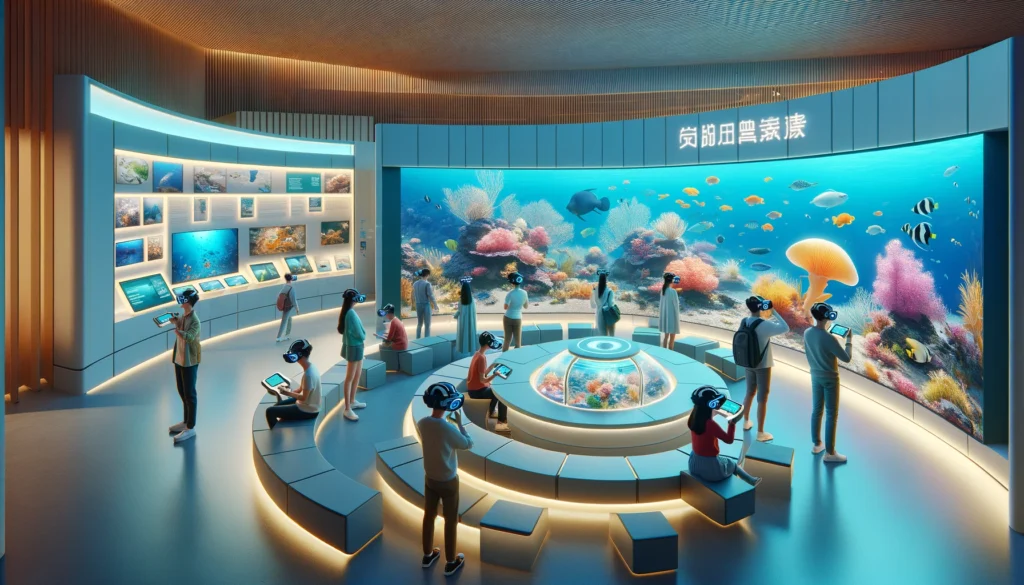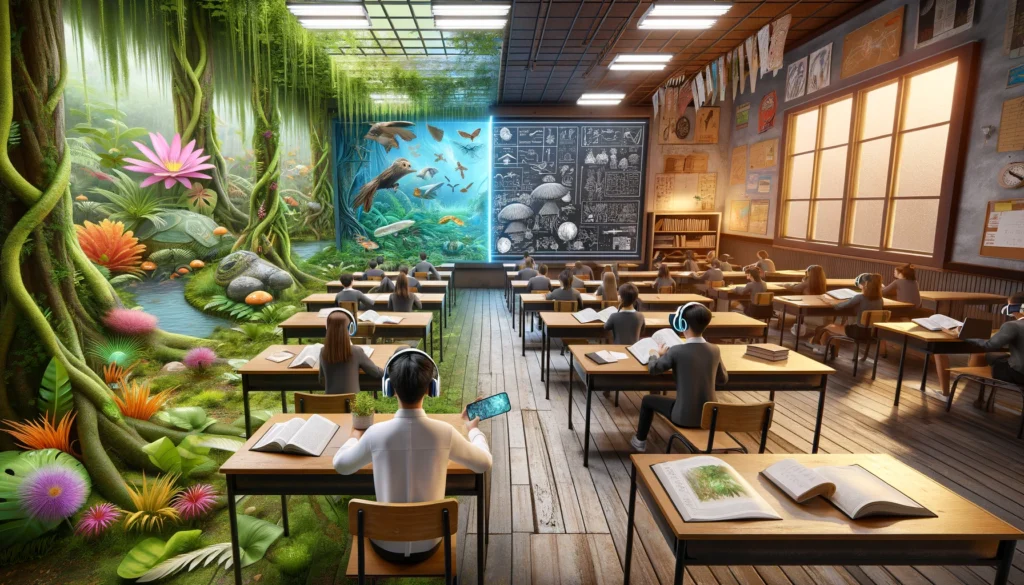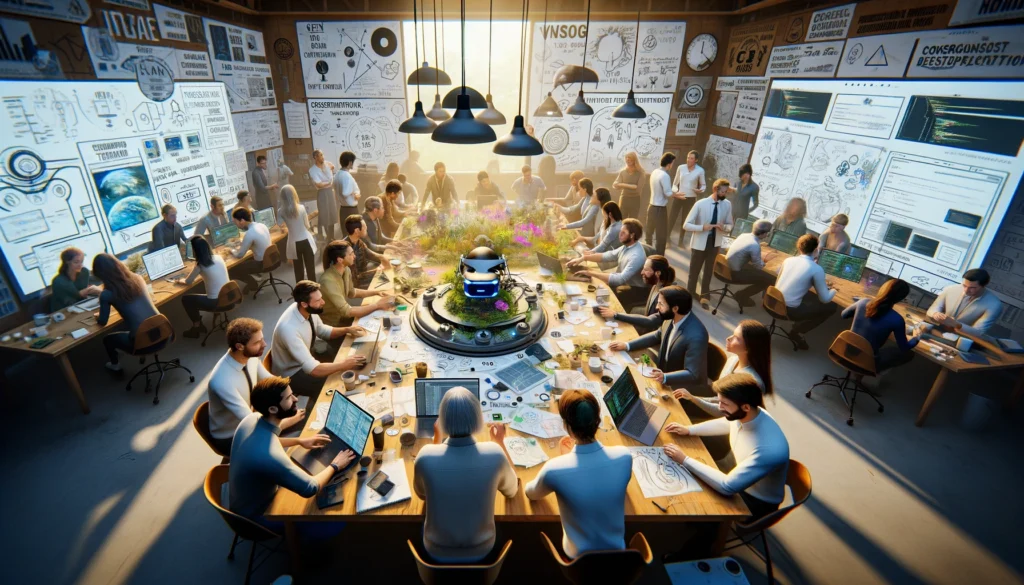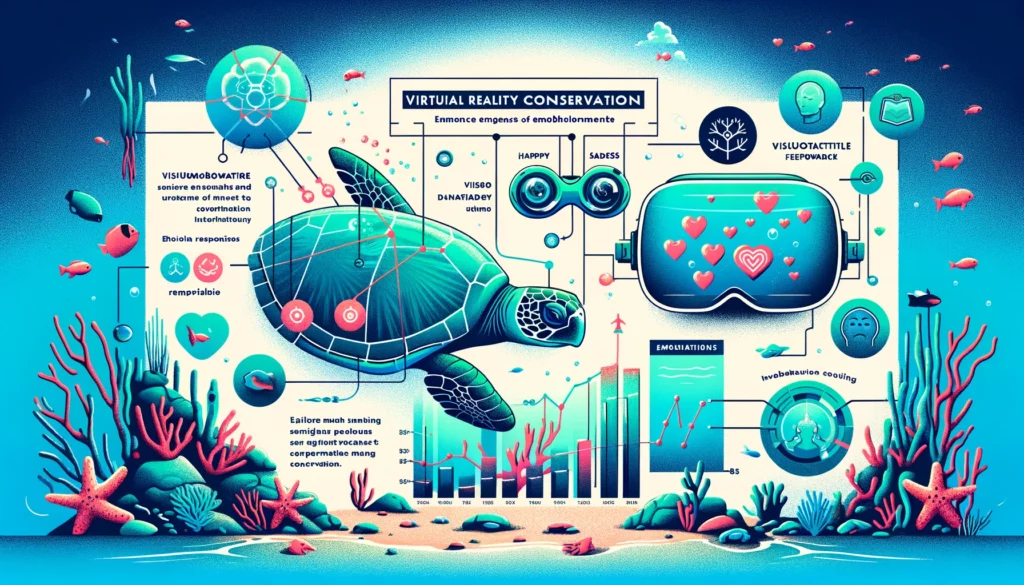Imagine stepping into the shoes, or rather, the flippers of a sea turtle, navigating through the ocean’s vastness. This isn’t a scene from a sci-fi movie but a glimpse into the world of Virtual Reality (VR)—a technology that’s not just for gamers or tech enthusiasts but a powerful ally for our planet’s conservation efforts.
As we delve deeper into the digital age, VR emerges as a beacon of hope in fields far beyond its original entertainment purposes. It’s transforming how we connect with and protect our environment, offering experiences that are as enlightening as they are immersive. But how exactly can putting on a VR headset make a difference in conserving nature? Let’s dive into a journey that’s about to change how we see the world around us.
The Influence of VR on Conservation Attitudes
Ever heard of “compassion fade”? It’s a concept that might sound complex, but it’s quite simple—and VR is putting it to the test. Imagine watching a story unfold through a VR headset, one that takes you up close to the struggles of a lone sea turtle caught in plastic. This powerful, solitary experience can stir something deep within us, more so than hearing about hundreds suffering from the same fate. Research published in Scientific Reports uncovers this phenomenon, revealing that participants exposed to the plight of a single turtle in VR were more inclined to open their wallets for conservation than those presented with multiple cases of distress.

This discovery taps into a profound aspect of human psychology, leveraging VR’s immersive nature to transform empathy into action. By focusing on individual stories, VR can forge a stronger connection between us and the cause, making the act of giving not just a response but a personal commitment to change.
Enhancing Connection and Empathy Through VR
But VR’s magic doesn’t stop at showcasing stories. It goes a step further by embodying us in the very essence of creatures like the sea turtle. Through what’s known as body transfer, VR lets us “become” another being, feeling what they feel through visuomotor and visuotactile feedback. This isn’t just about seeing the world from a different angle; it’s about experiencing life from a completely new perspective.

Studies exploring this facet of VR demonstrate its power to deepen our empathy and connection to conservation issues. When participants can virtually feel the ocean’s current against their skin or the struggle against encroaching plastic, the conservation message doesn’t just hit home—it settles in, urging a more profound and personal call to action.
In the next sections, we’ll explore how VR is not just a tool for empathy and engagement but a practical ally in conservation efforts, making a tangible difference in how we support and sustain our planet’s biodiversity.
Practical Applications of VR in Conservation
Virtual Reality is not just about experiencing the world through the eyes of another; it’s also about making a real-world impact. Conservation campaigns and projects are increasingly harnessing VR to draw attention and funds to their causes. A notable study published in PLOS ONE (a peer-reviewed open-access mega journal published by the Public Library of Science since 2006) puts this into perspective by examining how VR can boost donations for coral reef conservation. The research showed that when people experienced the vibrant life and challenges of coral reefs through immersive VR, they were more likely to donate compared to those who received the same information via traditional means.

This isn’t just about the novelty of VR; it’s about its unparalleled ability to evoke emotions and compassion. By providing an immersive dive into the underwater world threatened by climate change, pollution, and human activity, VR brings the urgency of conservation efforts to the forefront of people’s minds, encouraging a more immediate and heartfelt response.
Challenges and Slow Adoption in Ecology
Despite its potential, the adoption of VR in the field of ecology and conservation has been slower than in industries like architecture or engineering. This hesitation can be attributed to various factors, including the cost of VR technology and a lack of awareness about its potential benefits. However, as VR becomes more accessible and its applications in conservation become more widely recognized, we can expect to see a shift.

The slow adoption phase also offers an opportunity for pioneers in the field to experiment and find innovative ways to use VR to engage the public, educate on ecological issues, and promote conservation projects. The unique ability of VR to simulate complex ecological systems and visualize the impact of human activity on these systems presents a compelling case for its use in environmental education and advocacy.
Further Research and Development Needs
While VR holds great promise for conservation and environmental education, there’s a clear need for further research and development. As we venture deeper into the possibilities of VR, questions arise about how to optimize these experiences for maximum impact. How do we ensure that VR experiences lead to sustained engagement and action rather than momentary interest? What are the best practices for designing VR content that educates, inspires, and mobilizes?

Addressing these questions requires a collaborative effort among technologists, conservationists, educators, and policymakers. It’s not just about creating more immersive experiences but about understanding the long-term effects of these experiences on people’s attitudes and behaviors toward conservation.
Case Studies and Insights from Research
The research on Virtual Reality (VR) for conservation demonstrates how immersive technologies can significantly impact environmental awareness and conservation efforts. Here are more detailed insights:
- Compassion Fade and Donation Behavior: The Scientific Reports study provided a fascinating look into how VR can influence donation behavior through the concept of compassion fade. Participants who experienced a VR presentation featuring a single sea turtle in distress were more likely to donate to conservation efforts than those exposed to multiple sea turtles in distress. This suggests that VR’s immersive nature can make individual conservation stories more impactful, potentially increasing the effectiveness of fundraising efforts for conservation organizations.
- Embodiment in VR: The same study delved into the concept of body transfer (BT) in VR, where participants could experience life from the perspective of a sea turtle. This was achieved by leveraging visuomotor (movement) and visuotactile (touch) feedback, allowing participants to feel a sense of embodiment within the virtual sea turtle. Such experiences have shown promise in increasing empathy towards non-human species and fostering a greater connection to conservation issues. The study tested various combinations of visuomotor representation and visuotactile stimulation to find the optimal setup for enhancing body transfer and, by extension, empathy and conservation behavior.

- VR for Environmental Education and Fundraising: The study published in PLOS ONE explored the effectiveness of VR in raising funds for coral reef conservation. It specifically tested how different levels of visual immersion (low vs. high) and message framing (positive vs. negative) affected participants’ willingness to donate after experiencing a VR video about coral reefs. Findings suggest that immersive VR experiences can indeed enhance emotional engagement and increase the likelihood of donations compared to traditional media formats. This points to VR’s potential as a valuable tool in environmental education and fundraising, capable of eliciting stronger emotional responses and encouraging pro-social behavior.
- Utilization in Conservation Projects: Beyond these specific studies, VR’s application in nature conservation is broader and includes stakeholder engagement, ecological education, and the visualization of environmental impacts and conservation solutions. Despite its slow adoption in ecology compared to other fields, VR offers unique opportunities to engage the public in environmental issues by providing immersive experiences that traditional two-dimensional designs cannot. This can be especially useful in visualizing the benefits of conservation projects, enhancing public awareness, and encouraging investment in biodiversity.
These studies and insights highlight VR’s potential to transform how the public interacts with and supports conservation efforts. By offering immersive experiences that evoke empathy and a deeper understanding of ecological issues, VR technology can play a crucial role in promoting environmental awareness and action. However, as with any emerging technology, ongoing research and development are necessary to fully realize its potential in conservation and beyond.
Conclusion: A New Horizon for Conservation
The journey through the world of Virtual Reality and its application in environmental conservation is just beginning. As we’ve explored, from enhancing empathy and connection to practical applications in fundraising and education, VR holds immense potential to change how we relate to and protect our natural world. But realizing this potential fully requires ongoing research, development, and, most importantly, an openness to integrating new technologies into conservation strategies.

The path forward is as exciting as it is necessary. By continuing to explore and invest in VR technology, we can unlock new ways to connect with the planet and inspire action to protect it. The immersive experiences offered by VR are not just a window into the struggles of endangered species or threatened ecosystems; they are a call to action, a reminder of the capability of technology to drive positive transformation in the world.
As we look to the future, let’s embrace the possibilities that VR presents for environmental conservation. By doing so, we can ensure that the next generation inherits a world not just seen through a headset but experienced in all its natural beauty and diversity.
Author’s Note:
This blog aims to shed light on the transformative potential of VR, not just as a tool for immersive entertainment but as a pivotal ally in our ongoing efforts to protect and preserve our planet. The journey through VR’s impact on conservation is a testament to the innovative pathways we can take towards a more empathetic and proactive stance on environmental issues. Let’s remain open to the possibilities technology offers, embracing new methods to engage with and advocate for the precious world around us.
G.C., Ecosociosphere contributor.
References:
- Compassion Fade and Donation Behavior: The effects of embodying wildlife in virtual reality on conservation behaviors. Scientific Reports.
- VR for Environmental Education and Fundraising: Virtual reality as a tool for environmental conservation and fundraising. PLOS ONE.
- Utilization in Conservation Projects: How virtual reality can drive nature conservation. AECOM.





Comments
Thanks for sharing. I read many of your blog posts, cool, your blog is very good.
Thanks for sharing. I read many of your blog posts, cool, your blog is very good.